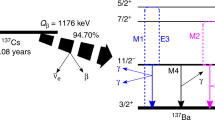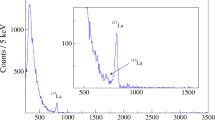Abstract
The double-gamma (γγ)-decay of a quantum system in an excited state is a fundamental second-order process of quantum electrodynamics. In contrast to the well-known single-gamma (γ)-decay, the γγ-decay is characterized by the simultaneous emission of two γ quanta, each with a continuous energy spectrum. In nuclear physics, this exotic decay mode has only been observed for transitions between states with spin-parity quantum numbers Jπ = 0+ (refs 1, 2, 3). Single-gamma decays—the main experimental obstacle to observing the γγ-decay—are strictly forbidden for these 0+ → 0+ transitions. Here we report the observation of the γγ-decay of an excited nuclear state (Jπ = 11/2−) that is directly competing with an allowed γ-decay (to ground state Jπ = 3/2+). The branching ratio of the competitive γγ-decay of the 11/2− isomer of 137Ba to the ground state relative to its single γ-decay was determined to be (2.05 ± 0.37) × 10−6. From the measured angular correlation and the shape of the energy spectra of the individual γ-rays, the contributing combinations of multipolarities of the γ radiation were determined. Transition matrix elements calculated using the quasiparticle–phonon model reproduce our measurements well. The γγ-decay rate gives access to so far unexplored important nuclear structure information, such as the generalized (off-diagonal) nuclear electric polarizabilities and magnetic susceptibilities3.
This is a preview of subscription content, access via your institution
Access options
Subscribe to this journal
Receive 51 print issues and online access
$199.00 per year
only $3.90 per issue
Buy this article
- Purchase on Springer Link
- Instant access to full article PDF
Prices may be subject to local taxes which are calculated during checkout




Similar content being viewed by others
References
Watson, B. A., Bardin, T. T., Becker, J. A. & Fisher, T. R. Two-photon decay of the 6.05-MeV state of 16O. Phys. Rev. Lett. 35, 1333–1336 (1975)
Schirmer, J. et al. Double gamma decay in 40Ca and 90Zr. Phys. Rev. Lett. 53, 1897–1900 (1984)
Kramp, J. et al. Nuclear two-photon decay in 0+ → 0+ transitions. Nucl. Phys. A 474, 412–450 (1987)
Mokler, P. H. & Dunford, R. W. Two-photon decay in heavy atoms and ions. Phys. Scr. 69, C1–C9 (2004)
Ilakovac, K., Uroic, M., Majer, M., Pasic, S. & Vukovic, B. Two-photon decay of k-shell vacancy states in heavy atoms. Radiat. Phys. Chem. 75, 1451–1460 (2006)
Göppert, M. Über die Wahrscheinlichkeit des Zusammenwirkens zweier Lichtquanten in einem Elementarakt. Naturwissenschaften 17, 932 (1929)
Göppert-Mayer, M. Über Elementarakte mit zwei Quantensprüngen. Ann. Phys. 401, 273–294 (1931)
Göppert-Mayer, M. Double beta-disintegration. Phys. Rev. 48, 512–516 (1935)
Hayes, A. C. et al. Two-photon decay of the first excited 0+ state in 16O. Phys. Rev. C 41, 1727–1735 (1990)
Beusch, W. Über Zweiquanten-Übergänge an Ba137. Helv. Phys. Acta 33, 363–394 (1960)
Basenko, V. K., Berlizov, A. N. & Prokopets, G. A. Estimation of the probability of two-photon decay of the 0.662 MeV 137Ba state. Bull. Russ. Acad. Sci. Phys. 56, 94 (1992)
Millener, D. J., Sutter, R. J. & Alburger, D. E. 2-gamma decay of the 662-keV isomer in 137Ba. Bull. Am. Phys. Soc. 56, DNP.CF.8 (2011); available at http://meetings.aps.org/link/BAPS.2011.DNP.CF.8 (2011)
Lister, C. J. et al. A search for 2-photon emission from the 662 keV state in 137Ba. Bull. Am. Phys. Soc. 58, DNP.CE.3 (2013); available at http://meetings.aps.org/link/BAPS.2013.DNP.CE.3 (2013)
Moran, K. et al. E5 decay from the Jπ = 11/2− isomer in 137Ba. Phys. Rev. C 90, 041303 (2014)
Friar, J. L. Low-energy theorems for nuclear Compton and Raman scattering and 0+ → 0+ two-photon decays in nuclei. Ann. Phys. 95, 170–201 (1975)
Soloviev, V. G. Theory of Atomic Nuclei: Quasiparticles and Phonons (Institute of Physics Publishing, Bristol, 1992)
Acknowledgements
This work was supported by the State of Hesse under the Helmholtz International Center for FAIR (HIC for FAIR) and by the German Research Council (DFG) under grant no. SFB 634. We thank D. J. Millener, R. J. Sutter for an open discussion and for generously sharing their preliminary results before publication, and C. J. Lister for discussions. H.S. thanks Dirk Schwalm for raising interest in this topic.
Author information
Authors and Affiliations
Contributions
C.W. and H.S. performed the data analysis and derived the equations given in Supplementary Information. C.W., H.S. and N.P. contributed to the interpretation of the results. C.W. and R.L. were responsible for the set-up of the LaBr3:Ce detector array and the data acquisition system. V.Yu.P. performed the QPM calculation. C.W., H.S., N.P. and T.A. prepared the manuscript. All authors discussed the results, commented on and contributed to the manuscript.
Corresponding author
Ethics declarations
Competing interests
The authors declare no competing financial interests.
Supplementary information
Supplementary Information
This file contains Supplementary Text and Data, Supplementary Figure 1, Supplementary Tables 1-4 and Supplementary References. (PDF 273 kb)
Rights and permissions
About this article
Cite this article
Walz, C., Scheit, H., Pietralla, N. et al. Observation of the competitive double-gamma nuclear decay. Nature 526, 406–409 (2015). https://doi.org/10.1038/nature15543
Received:
Accepted:
Published:
Issue Date:
DOI: https://doi.org/10.1038/nature15543
This article is cited by
-
Nuclear shell-model simulation in digital quantum computers
Scientific Reports (2023)
-
Electromagnetic character of the competitive γγ/γ-decay from 137mBa
Nature Communications (2020)
-
Observations on the long-lived Mossbauer effects of 93mNb
Scientific Reports (2016)
-
Sometimes γ-rays come in twos
Nature (2015)
Comments
By submitting a comment you agree to abide by our Terms and Community Guidelines. If you find something abusive or that does not comply with our terms or guidelines please flag it as inappropriate.



